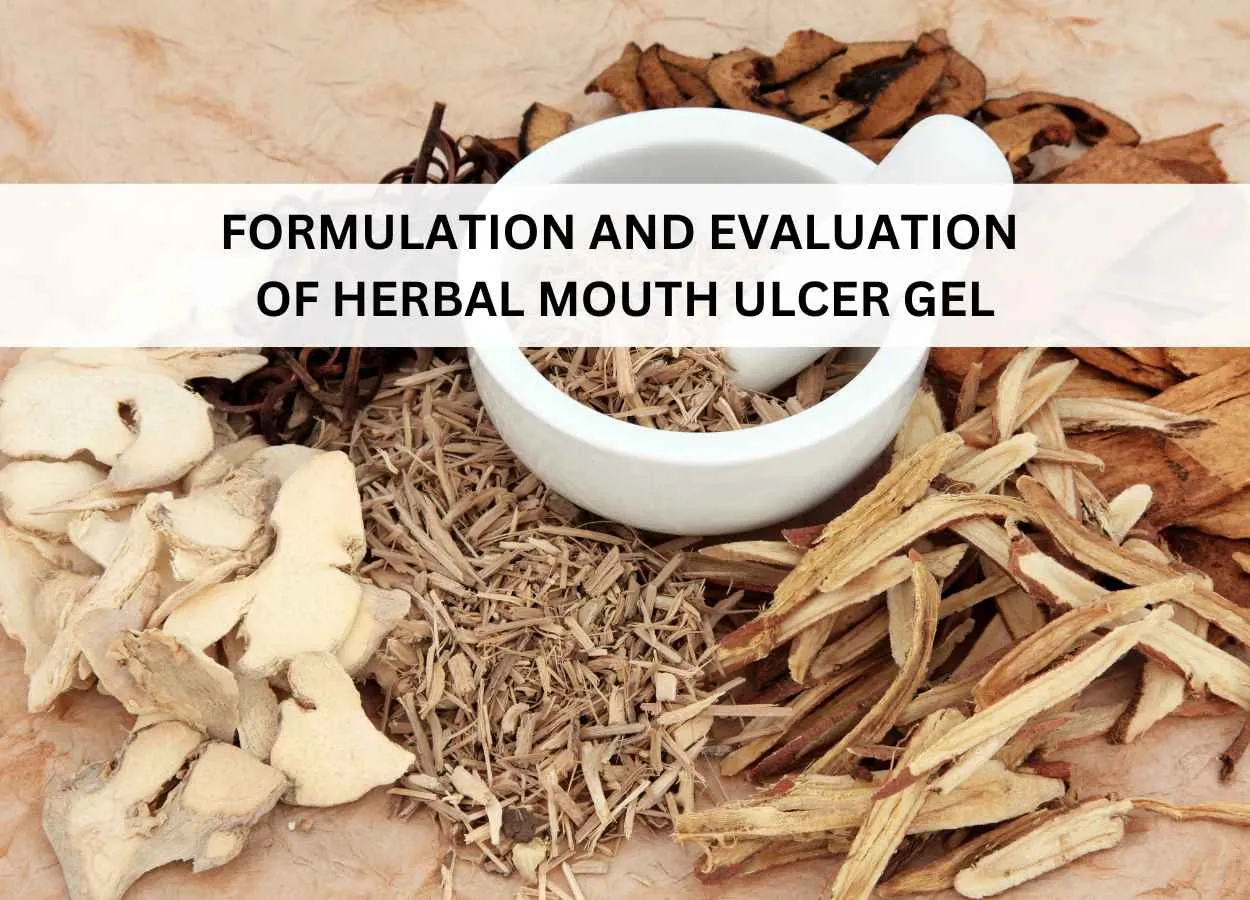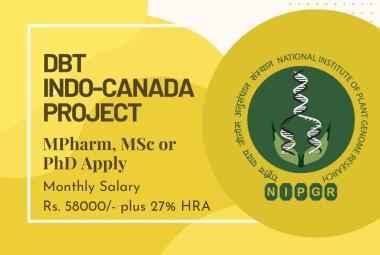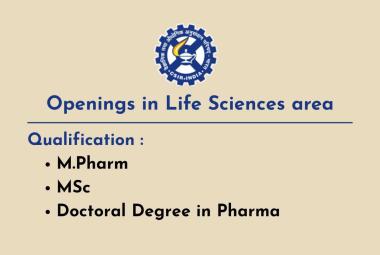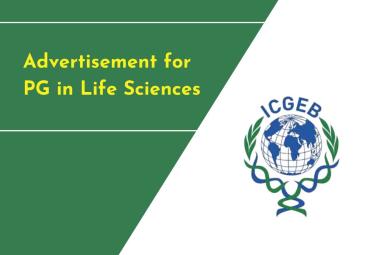About Authors
Pooja B. Jaiswal, Shyam S. Awate (Dept of Pharmaceutics)
IVM’s Indrayani Institute of Pharmaceutical Education and Research
Talegaon Dabhade, Talegaon Chakan road, Maval-Pune - 410507
ABSTRACT
Herbal medicines is still the mainstay of about 75-80% of the world’s population, mainly in developing countries, for primary health care because of better cultural acceptability, better compatibility with human body and lesser side effects. Herbal medicines consist of plant or its part to treat injuries, disease or illnesses and are used to prevent and treat diseases and ailments or to promote health and healing. It is a drug or preparation made from a plant or plants and used for any to such purpose. Herbal medicines are the oldest form of health care known to mankind. A gel is a soft, solid or solid-like material which consists of at least two components, one of them being a liquid, present in substantial quantity. There are number of synthetic gels in the market as compared to herbal or natural gel, but synthetic gels has some harmful effects on skin like irritation and dryness of skin. Now a days peoples are more aware about side effects and each and every ingredient using formulation of gel or any other formulation. Hence due to this reason there is increasing demand for natural ingredient containing formulation. The aim of this project was to formulate and evaluate herbal mouth ulcer gel. Therefore, developed formulations have potential to treat mouth ulcers. However, further clinical studies are required to establish clinical efficacy of prepared herbal gels.
Reference Id: PHARMATUTOR-ART-3006
INTRODUCTION
A gel is a solid or semi solid system of at least two constituents, consisting of a condensed mass enclosing and inter penetrated by a liquid. Gels and jellies are composed of small amount of solids dispersed in relatively large amount of liquid, yet they posses more solid-like than liquid-like character.The characteristic of gel and jelly is the presence of some form of cutaneous structure, which provides solid-like properties. Gels are Semi-Solids systems in which a liquid phase is contained within a 3-D polymer Matrix (consisting of natural or synthetic gum) having a high degree of physical or chemical cross-linking. Gels are aqueous colloidal suspensions of the hydrated forms of in soluble medicament. Gels are richer in liquid than magma.
Gel is the most common form of ulcer treatment. gels are primarily been products aimed at curing the mouth ulcer In the present scenario, it seems improbable that herbal gel, although better in performance and safer than the synthetic ones, will be popular with the consumers. A more radical approach in popularizing herbal gel would be to change the consumers’ expectations from a gel, with emphasis on safety and efficacy. The present paper emphasizes on composition, formulation, methods of evaluation of herbal mouth ulcer gel.
There is an increasing demand of herbal gel for maintaining and curing mouth ulcer, but synthetic gel, may include a number of harmful toxins which can be produce sever side effect. Global interest toward Herbal cosmetic is rising because of safety, as a products or home-made formula. Synthetic components are added to gel primarily for maintaining stability and drug concentration. Herbal formulations are considered as alternative to synthetic gel but formulating gel using completely natural raw material is a difficult task. There are large numbers of medicinal plants which are reported to have beneficial effects on skin and are commonly used in formulation of gel . These plant products may be used in their powdered form, crude form, purified extracts, or derivative form . It is extremely difficult to prepare a herbal gel using a single natural material that would be milder and safer than the synthetic ones.
The gels are having many advantages such as:
a) Gel can avoid gastrointestinal drug absorption difficulties caused by gastrointestinal pH.
b) Gels are having property to avoid enzymatic activity and drug interaction with food and drinks.
c) They can substitute for oral administration of medication when the route is unsuitable.
d) They can avoid the first pass effect, that is, the initial pass of drug substance through the human body.
e) They avoid systemic and portal circulation following gastrointestinal absorption.
f) Gels are not deactivated by liver enzymes because the liver is bypassed.
g) They are non-invasive.
h) They have good patient compliance.
i) They are applied over skin for slow and prolonged absorption.
j) Gels have also been applied in pharmacy to some viscous suspension for oral use for example Aluminium hydroxide gel.
k) They have localized effect with minimum side effects.
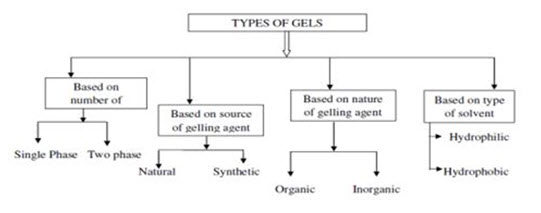
An oral ulcer which occurs on the mucous membrane of the oral cavity is called aphthous ulcer, or canker sore. Aphthous ulcer, is a common condition affecting oral mucosa, and has the property of self-healing. It is a known fact that oral aphthous ulcers affect between 5 to 25% of population of any age group. The main types of oral ulcers are minor ulcers. These are around 2-8 mm in diameter and usually clear up in 10 to 15 days. Major ulcers are bigger and deeper, often with a raised or irregular border. These can take several weeks to heal and may leave a scar in the mouth.
The herbal gel was formulated using natural ingredients with Guava leaves extract(Antioxidant effect), Betal leaves extract(Reduce bacterial growth), Liquorice Root(Reduce pain), Mentha oil / Peppermint oil(Use to treat mouth ulcers), Punica granatum extract(Use to treat small ulcers), Carbopol 934 P % (Mucoadhesive polymer), Methyl Paraben (Antifungal preservative), Propyl Paraben(Preservative), Triethanolamine(Neutralizer), Acacia extract(Gelling agent) and Distilled Water.
Formulation of herbal mouth ulcer gel
|
Sr.no |
Ingredients |
Importance |
Quantity |
|
1 |
Guava leaves |
Antioxidant effect |
10mg |
|
2 |
Betal leaves |
Reduce bacterial growth |
10mg |
|
3 |
Liquorice Root |
Reduce pain |
8mg |
|
4 |
Mentha oil / Peppermint oil |
Use to treat mouth ulcers |
2ml |
|
5 |
Punica extract |
Use to treat small ulcers |
5mg |
|
6 |
Carbopol 934 P % |
Mucoadhesive polymer |
1 g |
|
7 |
Methyl Paraben |
Antifungal preservative |
0.015 |
|
8 |
Propyl Paraben |
Preservative |
0.01 |
|
9 |
Triethanolamine |
Neutralizer |
q.s. PH 6-7 |
|
10 |
Acacia extract |
Gelling agent |
5mg |
|
11 |
Distilled Water |
|
Use upto 100ml |
MATERIALS
1) Guava Leaves : (Antioxidant effect)
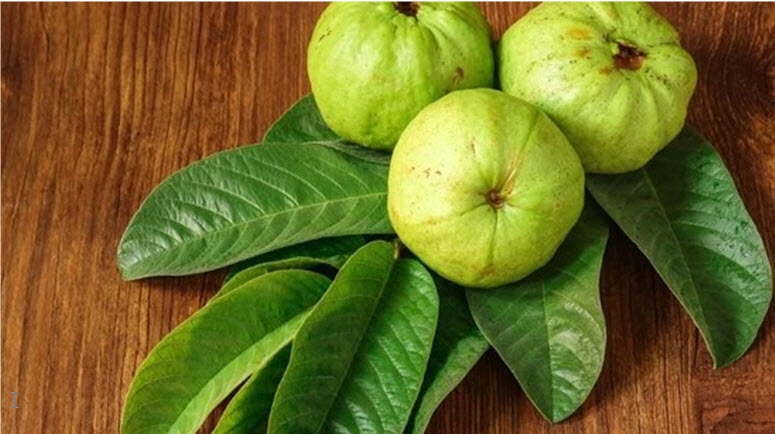
Significance: “Bayabas” or guava (Psidium guajava) is a plant of the family Myrtaceae.1 In the backyards of most Filipino homes in the rural countryside, this plant is commonly seen and grown because of its many uses as fruit and as traditional remedy to treat various ailments. Research studies have shown that almost all of the parts of this plant have medicinal qualities, making it one of the most popular therapeutic plants in the Philippines and one of the approved medicinal plants of Department of Health.
Guava (Psidium guajava) is a small tree that can grow up to 3 meters tall. The fruit, bark and leaves are used as herbal medicine. A decoction of its leaves is recognized for its effectiveness in curing several ailments, including the treatment of chronic diarrhea and gastroenteritis. The most common use of the leaves is for cleaning and disinfecting wounds by rinsing the afflicted area with a decoction of the leaves. It can also be used as a wash for uterine and vaginal problems, and is good for ulcers. Leaf decoction Guava leaves have been used a long time to manage oral hygiene. In order to reduce gum inflammation, relieve pain, control plaque, and freshen your breath, crush five to six tender guava leaves with a mortar and pestle. Add them to 1 cup of boiling water and allow it to simmer for about 15 minutes.
From the experimental evidence of invitro studies it was observed that powdered guava leaves contain flavonoids so it showed significant antioxidant effect. Developed herbal formulation was stable, safe and effective over to synthetic formulations for the treatment of mouth.
Can guava leaves cure mouth ulcers?
Guava leaves mouthwash was effective for aphthous ulcers in terms of reduction of symptoms of pain and faster reduction of ulcer size. Further clinical trials comparing this mouthwash against other treatment options are recommended.
The effectivity of guava leaves in pain alleviation may largely be due to the numerous flavonoids, tannins, polyphenolic compounds, ellagic acid, triterpenoids, guiajaverin, quercetin and other chemical compounds present in the plant.10 Flavonoids inhibit biosynthesis of prostaglandins, which are involved in various immunologic responses and are the end products of the cyclooxygenase and lipoxygenase pathways.18 Protein kinases are another class of regulatory enzymes affected by flavonoids. Inhibition of these enzymes provides the mechanism by which flavonoids inhibit inflammatory processes.
2) Betal Leaves: (Reduce bacterial growth)
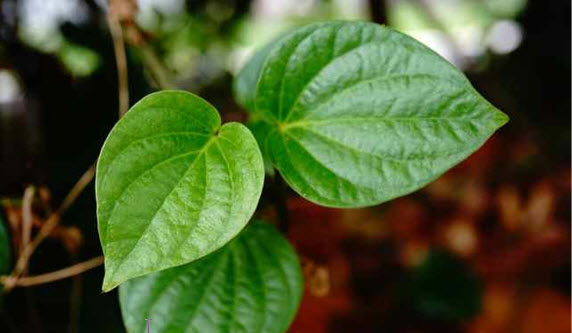
Significance : The betel (Piper betel) is a vine of the family Piperaceae, which includes pepper and kava. Chewing betel leaf (Piper betle Linn.) prevents orodental disease. Betel is known to worldwide and is consumed frequently as a mouth freshener. Betel is one of the herbs that is closely related to caries control, periodontal disease, conserve the teeth and control of halitosis (Hossain et al., 2017; Shah et al., 2016). Anticancer potential Betel is one of the herbs that is closely related to the prevention of oral cancer. Betel leaf contains antioxidants like vitamin C, vitamin A, riboflavin, chlorophyll and phenolic is high, so it can cure cancer sores and toothache. Betel leaves as well as their active phenolic compound eugenol exhibited strong anticancer activity in oral carcinoma cells. The anticancer effect of the extract was attributable to the component phenolics, eugenol respectively in betel leaves, as the phenolics also exhibited strong cytotoxicity in cancer cells (Dwivedi et al., 2010; Pradhan et al., 2013; Surono, 2016). It also contains enzyme-like diastase and to possess anticancer potential (Hussain etal., 2017; Shah et al., 2016). Anti Dental Caries Activity. Dental caries result from demineralization of enamel and then dentin by the acid produced by plaque microorganisms as they metabolize dietary carbohydrates. Betel leaves is the best natural ingredient in dental caries control in Asia, which provides the best oral and contribution oral.hygiene (Chauhan et al., 2016). Results of the study showed the extract of betel leaves may exert anti carcinogenic activities related to a decrease in acid production and changes to the ultrastructure of Streptococcus mutans (Shah et al., 2016). Strengthen teeth Chewing betel leaves can strengthen teeth, because its contains vitamins and minerals such as ascorbic acid, thiamine, niacin, riboflavin, carotene, Mg, K, Ca, Fe, I, P and Zn (Grober, 2009; Hussain et al., 2017; Shah et al., 2016). The leaves are nutritive and hold a considerable quantity of vitamins and minerals and therefore, six leaves with a small bit of slaked lime are said to be equivalent to about 300 ml of cow milk It may protect against cancer.It may be an antioxidant.It may prevent the growth of fungi.It may protect against allergic reactions.It may heal wounds.It may be used in case of constipation.mainly for vitamin and mineral nutrition (Chauhan et al.,2016). Betel leaf contains vitamin C, essential oils and antioxidants (vitamin A, riboflavin and chlorophyll) is high, besides that it also contains calcium, phosphorus, iron, iodine, nicotinic acid, thiamine, and potassium, so it can strengthen teeth.
3) Liquorice Root: (Reduce pain)
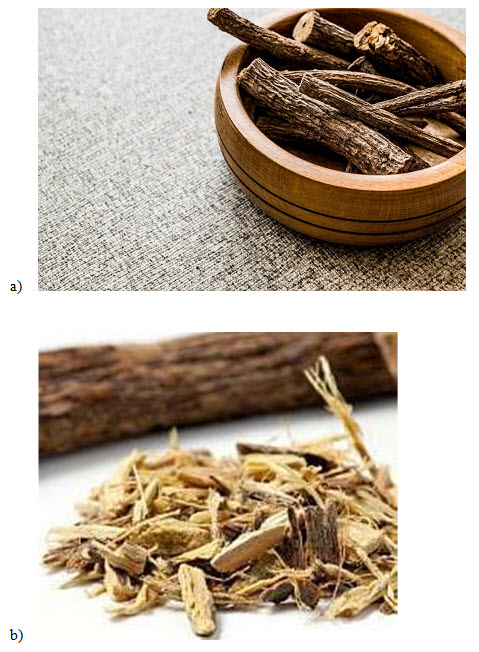
Significance : Liquorice also known as yashtimadhu, sweetwood or mulhatti is one such herbal remedy which has shown to have immense potential in treatment of orofacial diseases. Liquorice is rich in secondary metabolites which are used in cosmetics, foods, traditional and modern medicine. It has well known properties such as antiviral, glucocorticoid, anti-inflammatory, antioxidant, anti-ulcerative, anti-carcinogenic and many more. Liquorice extracts and liquorice bioactive ingredients such as glabridin, licoricidin, licorisoflavan A, licochalcone A, and glycyrrhizin have shown beneficial effects in preventing and treating oral diseases. This paper reviews the effects of liquorice and its constituents on oral diseases such as dental caries, periodontitis, gingivitis, candidiasis, recurrent aphthous ulcer and oral cancer and its use as a root canal medicament and summarizes the results of clinical trials that investigated the potential beneficial effects of liquorice and its constituents as a prevention and treatment modality in oral diseases. Clinical trials, case reports and review of literature evaluating the effect of liquorice on oral micro-organisms and oral diseases are included. Literature pertaining to the effects of liquorice on systemic diseases.
Liquorice is rich in secondary metabolites which have been associated with various health benefits. Secondary metabolites of liquorice roots have shown to have a beneficial effect in the treatment of various diseases such as cancer, tuberculosis, atherosclerosis, gastric ulcers, immunodeficiency, hepatitis and bacterial infection.
4) Mentha Oil / Peppermint Oil: (Use to treat mouth ulcers)
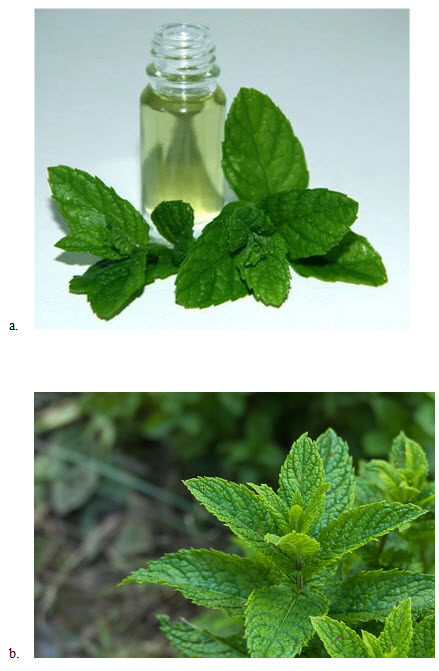
Significance : Peppermint, botanically known as Mentha piperita L. is an aromatic perennial herb, producing creeping stolons and belongs to family Lamiaceae. Mint leaves also helps in treating gastritis problem, ulcers and strengthens liver. furthermore, mint can be used in fresh, dry, paste or in oil form for skin and oral care.
Peppermint oil comes from the peppermint plant, which is a hybrid of spearmint and water mint. People have used peppermint oil for centuries to treat a range of illnesses, including digestive conditions, colds, and headaches.
traditional herbalism, practitioners may use peppermint to:
1. kill germs
2. stop itching
3. relieve pain
4. prevent or reduce vomiting
5. help the body eliminate mucus
6. reduce muscle spasms
7. reduce flatulence
8. promote sweating
9. boost blood circulation
Here are the peppermint oil benefits that have the strongest scientific evidence behind them:
Its natural anti-inflammatory and anti-bacterial properties help curb the growth of bacteria in the mouth, further preventing infections.
It is an amazing treatment for post tooth-extraction. It helps prevent the swelling in connective tissues and reduces bleeding too.
The presence of potassium, magnesium, calcium, iron and phosphorus in mint leaves is essential for maintenance and formation of bone-density in tooth and jaw.
The vitamins and minerals work together to fortify enamel and ensure strengthening teeth and gums.
It acts as an alkaline food that contradicts the effects of the acidic environment that is responsible for gum diseases and tooth decay.
Chewing on mint leaves can help keep your mouth moist and fresh. It stimulates the production of saliva and the enzymes that are important for digestion.
5) Punica Extract: (Use to treat small ulcers)
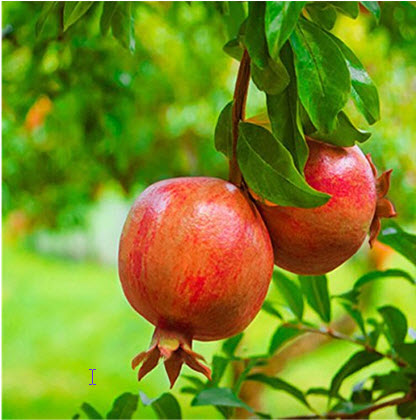
Significance : Pomegranate (Punica Granatum Linn), belongs to the Punicaceae family, and has been used from ancient times to confer health benefits with regard to a number of injuries and diseases. The potential therapeutic properties of pomegranate are wide-ranging and include treatment of inflam-matory conditions, cancer, cardiovascular disease, diabetes and dental condition. Almost all parts of a pomegranate have biological activities and are used in treatment. Pomegranate peel (skin, rind or husk), is characterized by an interior network of membranes, and holds substantial amounts of beneficial phenolic compounds, including flavonoids (anthocyanins and catechins) and hydrolyzable tannins (punicalin, punicalagins, gallic acid and ellagic acid). Potential of pomegranate peel has been widely recognized [8], for example, traditionally, aqueous pomegranate peel extract (PPE) obtained by boiling, has been used to treat dental plaque and aphthae. Indeed, over the past few decades, scientific investigations have laid a credible basis for some of the traditional uses of the pomegranate peel. Pomegranate peel has exhibited a high antioxidant potential. PPE and its bioactive ellagitannins (500-10,000 mg/L)
have the ability to inhibit free radical generation in UVA-and UVB-irradiated human skin, consequently protecting it from DNA damage [14]. PPE has been also demonstrated to inhibit inflammation and allergic reactions. The anti-inflammatory components of pomegranate, i.e., punicalagin and punicalin, significantly reduce production of nitric oxide and prostaglandin E2 [15,16]. Ouachrif et al. reported anti-inflammatory properties of the PPE following intraperitoneal and intra-cerebroventricular administration in rats. The experiments indicated pain index reduction and a significant decrease in egg albumin induced hind paw inflammation
6) Carbopol 934 P % : (Mucoadhesive polymer)
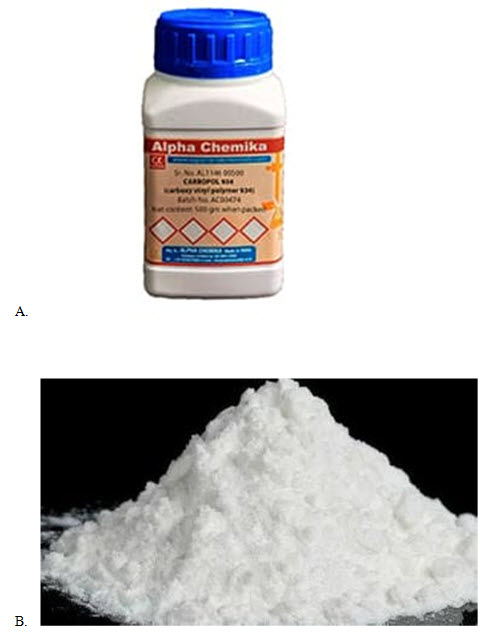
Significance: The agent must be selected appropriately as one of the determining parameters that can affect the nature and physical stability of the gel because it can affect the absorption of active substances on the skin. One of the gelling agents often used is carbopol. Carbopol is an acrylic polymer. It is non-toxic and non-irritable with repeated use so that it is suitable for gel preparations. It will form a transparent and bioadhesive gel. The advantages of carbopol gelling agents are that they can be developed in room temperature water, unlike hydroxypropyl methylcellulose which needs to be developed in hot water. In addition, the selection of carbopol 940 is due to its large viscosity range of 40,000-60,000 cP. The concentration of carbopol 940 gelling agent directly affects the viscosity of the preparation which also affects the physical properties of the gel preparation. The other gel component is the active substance. Active substances can affect the physical properties of gel preparations and their stability. The results of a study conducted by Bankar and Dole show the effect of the concentration of banana leaf extract (Musa acuminata) on the physical properties of gels using carbopol 940 gelling agent in which large extract concentration can increase the spreadability and viscosity. The study shows that in addition to gelling agents, there are concentrations of extracts that affect the physical properties of the preparations. Each different active ingredient requires optimization of the gelling agent concentration. Therefore, research must be carried out of how the influence of carbopol 940 gelling agent on gel preparations in order to be able to do the right formulation and obtain a good preparation in physical properties and drug release. II. METHOD This was a systematic review research. This research was conducted by studying the literature and testing critical knowledge and related thought. The result of the study was used to answer the problem statements determined by the researchers. The data source of this research was secondary data obtained from the literature. Sources of information were obtained from the database of PubMed, ScienceDirect, and Google Scholar. Preliminary research results were used as a secondary data source by examining research relevant to the formulation of the problem. Data collection process used was data extraction method using PICO (Population, Intervention, Compare, Results). The strategic method was to find journals using keywords ("comparison of carbopol 940 compositions" or "carbopol 940; safety; carbopol 940" or "carbopol.
preparations are that it can be easily applied and easily spread evenly when applying. It also provides a cool sensation and does not cause scars on the skin due to its transparent nature. Gel formulations consist of active substances, gelling agents and other additives. The concentration of the gelling agent must be selected appropriately as one of the determining parameters that can affect the nature and physical stability of the gel because it can affect the absorption of active substances on the skin. One of the gelling agents often used is carbopol. Carbopol is an acrylic polymer. It is non-toxic and non-irritable with repeated use so that it is suitable for gel preparations. It will form a transparent and bioadhesive gel. The advantages of carbopol gelling agents are that they can be developed in room temperature water, unlike hydroxypropyl methylcellulose which needs to be developed in hot water. In addition, the selection of carbopol 940 is due to its large viscosity range of 40,000-60,000 cP. The concentration of carbopol 940 gelling agent directly affects the viscosity of the preparation which also affects the physical properties of the gel preparation. The other gel component is the active substance. Active substances can affect the physical properties of gel preparations and their stability. The results of a study conducted by Bankar and Dole show the effect of the concentration of banana leaf extract (Musa acuminata) on the physical properties of gels using carbopol 940 gelling agent in which large extract concentration can increase the spreadability and viscosity. The study shows that in addition to gelling agents, there are concentrations of extracts that affect the physical properties of the preparations. Each different active ingredient requires optimization of the gelling agent concentration. Therefore, research must be carried out of how the influence of carbopol 940 gelling agent on gel preparations in order to be able to do the right formulation and obtain a good preparation in physical properties and drug release. II. METHOD This was a systematic review research. This research was conducted by studying the literature and testing critical knowledge and related thought. The result of the study was used to answer the problem statements determined by the researchers. The data source of this research was secondary data obtained from the literature. Sources of information were obtained from the database of PubMed, ScienceDirect, and Google Scholar. Preliminary research results were used as a secondary data source by examining research relevant to the formulation of the problem. Data collection process used was data extraction method using PICO (Population, Intervention, Compare, Results). The strategic method was to find journals using keywords ("comparison of carbopol 940 compositions" or "carbopol 940; safety; carbopol 940" or "carbopol 940; eye preparation" or "drug release; carbopol 940"). Journals relevant to the aims of study were used to composed this literature. These journals contain physical properties, the release of gel preparations containing carbopol 940 and the safety of carbopol 940 in eye drops. Inclusion Criteria: • Gel preparation of carbopol 940 • Carbopol 940 as a gel-forming agent • The effect of carbopol 940 used in gel preparations • Drug release of gel preparation of carbopol 940 Exclusion Criteria: • Combination of carbopol 940 with other carbopol Advances in Health Sciences Research, volume 34Proceedings of the International Conference.
7) Methyl Paraben : (Antifungal preservative)
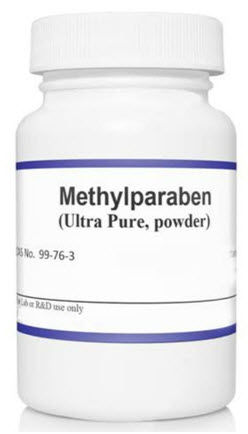
Significance : Methylparaben is frequently used as a preservative in cosmetics to prevent the growth of bacteria and mold in products that would otherwise be susceptible to microbial growth. It is a broad spectrum antimicrobial agent that is effective over a widespread pH range.
Combinations of methyl and propylparabens are commonly employed to achieve better antimicrobial results. Parabens antimicrobial activity is generally considered to be pH-independent under values of 8.0 where they are fully undissociated.
8) Propyl Paraben: (Preservative)
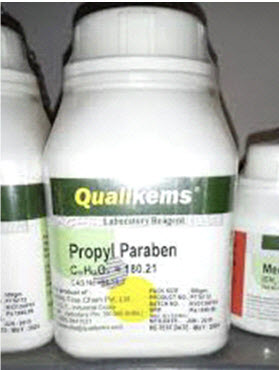
Significance : Propylparaben is the benzoate ester that is the propyl ester of 4-hydroxybenzoic acid. Preservative typically found in many water-based cosmetics, such as creams, lotions, shampoos and bath products. Also used as a food additive. It has a role as an antifungal agent and an antimicrobial agent
9) Triethanolamine: (Neutralizer)
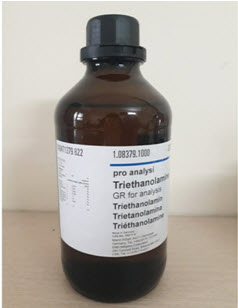
Significance : Triethanolamine, or TEA is a viscous organic compound that is both a tertiary amine and a triol. A triol is a molecule with three alcohol groups. Approximately 150,000 tonnes were produced in 1999. It is a colourless compound although samples may appear yellow because of impurities. Triethanolamine is found are sunscreen lotions, liquid laundry detergents, dishwashing liquids, general cleaners, hand sanitizers, polishes, metalworking fluids, paints, shaving cream and printing inks.
Stabilizes emulsions: As an emulsifier or stabilizer, triethanolamine helps emulsions, such as creams and lotions, last longer, according to Romanowski. Thickens the formula: Schultz adds that as far as sensory or aesthetic benefits, triethanolamine also helps thicken and add body to the formula.
Triethanolamine is used primarily in making surfactants, such as for emulsifier. It is a common ingredient in formulations used for both industrial and consumer products. The triethanolamine neutralizes fatty acids, adjusts and buffers the pH, and solubilizes oils and other ingredients that are not completely soluble in water. Triethanolammonium salts in some cases are more soluble than salts of alkali metals that might be used otherwise, and results in less alkaline products than would from using alkali metal hydroxides to form the salt. Some common products in which triethanolamine is found are sunscreen lotions, liquid laundry detergents, dishwashing liquids, general cleaners, hand sanitizers, polishes, metalworking fluids, paints, shaving cream and printing inks.
10) Acacia extract: (Gelling agent)
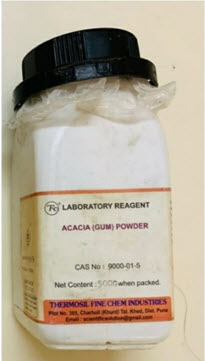
Significance: Acacia has been used in medicines, baking ingredients, tools, and woodwork for centuries. It has a long history in civilizations as ancient as the Egyptians and the aboriginal tribes of Australia. These kingdoms and tribes used acacia in surprisingly diverse ways, from making desserts to treating hemorrhoids. The first species ever discovered was given the name Acacia nilotica by the Swedish scientist Carl Linnaeus in the 1700s, and since then, nearly 1,000 species have been added to the Acacia genus relieves pain and irritation.
Acacia gum has a naturally sticky texture. Materials with this property are often used to reduce irritation and inflammation. The gum has been shown to be especially effective in easing stomach or throat discomfort.
Methodology
1. Materials and Method
a) Collection of Materials
The leaves of Psidium guajava betel leaves and punica granatum linnwere collecetd from medicinal garden.
b) Preparation of Extracts
The juice of guava leaves was macerated with ethenol 95% and obtain the extract of guava leaves. The leaves of betel and punica were dried and retain the phytoconstituents and macerated separately all extracts were stored at room temperature.
c) Phytochemical Screening
All the above prepared extract were subjected to preliminary phytochemical screening tests to identify the presence of various components, by using different tests and reagents.
d) Formulation of Gel
Take a leaves of guava ,betel punica fruit or leaves as per convenience then we have to prepare the extracts of the respected main ingredient. Take all the leaves wash it weight it using weighing machine such as guava, betel leaves are grinded and prepare the extract Liquorice is taken in small amount triturate the leaves and make the thin paste. Extract the filters swaras fresh juice using musklin cloth or filter paper. Concentrate the swaras on water bath upto thick viscous consistency.A sufficient amount of Carbopol 934 was soaked in distilled water overnight, and then mixed with distilled water with continuous stirring using a mechanical stirrer. Another solution containing varying concentrations of and the required quantity of methyl paraben and propyl paraben were added with continuous stirring.Propylene glycol was also added to the solution. This prepared solution was further mixed with carbopol 934 solution thoroughly with continuous stirring, volume was made upto 30ml with water and the pH was adjusted by addition of triethanolamine to obtain gel of required consistency. 1gm of carbopol is dissolved in 100ml of distilled water. Keep it on magnetic stirrer for mixing 15 min.then mix the leaves mixture carbopol and peppermint oil is added acacia were added in the very small amount in leaves swarus then mix all throughly. and gel is prepared.
Evaluation of Herbal Gel
i. Visual Appearance
The prepared gels were tested for color, clarity, texture, transparency and presence of any gritty particles.
ii. Measurement of pH
The pH of herbal gel formulations were determined by using digital pH meter. 1 gm of gel was taken and dispersed in 10 ml of distilled water and keep aside for two hours. The measurement of pH of formulation was carried out in three times and the average values are reported. pH of gel formulation was reported.
iii. Homogeneity
All developed gel formulations were tested for homogeneity by visual inspection after the gels have been set in to the container. They were tested for their presence and appearance of any aggregates.
iv. Spreadability
Spreadability is expressed in terms of time in seconds taken by two slides to slip off from gel that is placed in between the slides under the direction of certain load. If the time taken for separation of two slides is less then better the spreadability.. Spreadability is calculated by using the formula:
• S = M × L / T
• Where M = weight tied to upper slide
• L = length of glass slides
• T = time taken to separate the slides
Spreadabilty of gel formulations were reported
v. Viscosity
The viscosity of all the prepared formulations were analysed by the Brookefields viscometer with helipath, using spindle number 96 at 10 rpm.
Result and Discussion
The prepared gel formulations were evaluated for parameters such as physical appearance, pH, homogeneity, spread ability and viscosity. The observation reveals that the gels were having smooth texture and were elegant in appearance.
The gels showed good spreadability. Also from the above data it was observed that increase the concentration of plant extract increases the spreadability. All the prepared gels showed good homogeneity with absence of lumps. The developed preparations were much clear and transparent. The viscosity of all the developed gels was found to be excellent and with in the range.
Conclusion
The main aim first to formulate herbal oral mouth ulcer gel that will cure mouth ulcer and reduce pain and irritation and side effects too.
As seen from the results, it is possible to formulate herbal mouth ulcer gel by using guava leaves and betel leaves which is useful to treat the ulcer. From above study it is concluded that all preliminary test and stability studies suggested for utility of herbal mouth ulcer gel with economy and consumer compliance.
Nowadays there is a lot of demand for herbal formulations in the market due to their cost effectivity and absence of any side effects. From the above experimental data it is clear that a gel formulation with herbal ingredients such as guava, betel and punica has good characteristics, viscosity and also possesses a good antimicrobial activity which is necessary in the management of mouth ulcers.
References
Sheiham A. (2005) Oral health, genral health and quality of life. Bull World Health Organ; 83; 644
Mohsin J. Jamadar et al. (2017) SGVU Journal of Pharmaceutical Research & Education, Preparation And Evaluation Of Herbal Gel Formulation; 2(1); 201-224
Vani Madaan et al (2022) , Herbal mouth ulcer gel : A Review; Journal of Fundamental & Comparative Research Vol. VIII, No. 1(XVI); 20-25
Nem Kumar Jainet al (2020) Formulation and Evaluation of Polyherbal Aqueous Gel from Psidium guajava, Piper betel and Glycerrhiza glabra Extract for Mouth Ulcer Treatment. Res. J. Pharmacognosy and Phytochem.; 12(3); 145-148.


